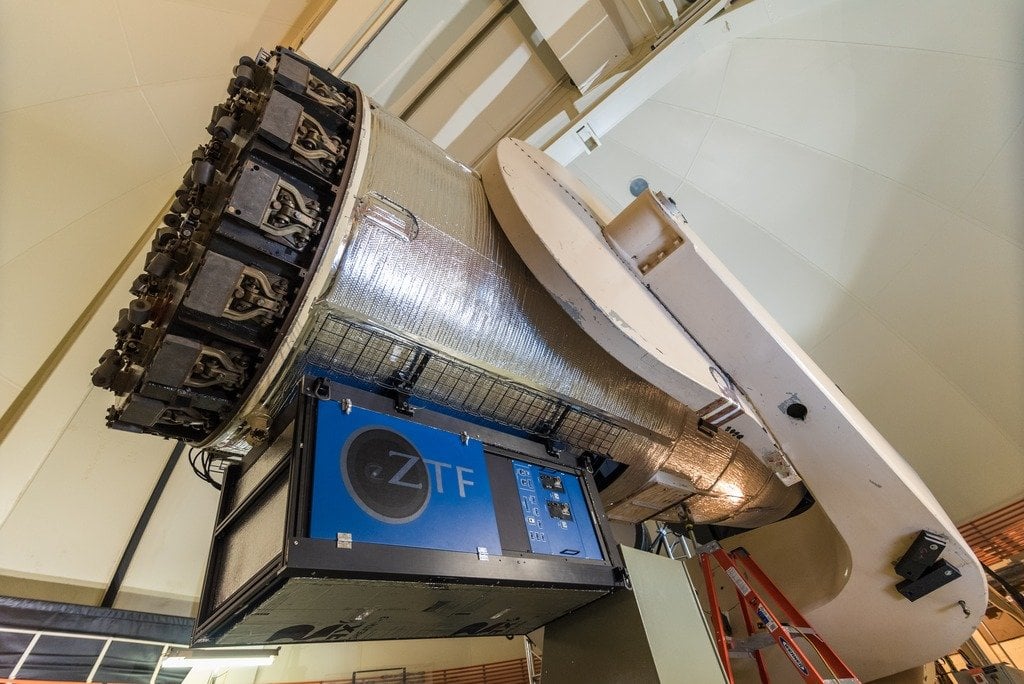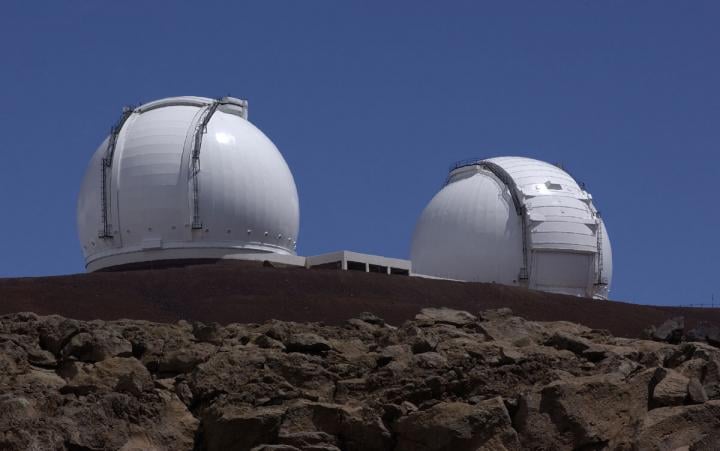Astronomers have been observing the gravitational bending of light since 1919, just a few years after Einstein developed the theory, but the transient nature of supernovae makes events such as SN Zwicky, also known as SN 2022qmx, very hard to spot.

The ZTF instrument at Palomar Observatory.
Credit: Caltech Optical Observatories
In fact, while scientists have spotted lensed duplicated images of distant objects called quasars many times before, only a handful of supernovae lensed into duplicated images have been found. Two of these cases were found at Palomar: SN Zwicky, and ciPTF16geu, discovered by the intermediate Palomar Transient Factory (iPTF), a predecessor to ZTF.
“SN Zwicky is the smallest resolved gravitational lens system found with optical telescopes. iPTF16geu was a wider system but had larger magnification,” says Goobar.
Goobar and his international team employed a suite of astronomical facilities to follow up and study SN Zwicky after ZTF discovered it. The Near-IR Camera 2 (NIRC2) at the W. M. Keck Observatory on Maunakea in Hawai‘i resolved SN Zwicky, revealing that the lensing of the supernova was strong enough to have created multiple images of the same object.

The two 10-meter Keck telescopes on Mauna Kea in Hawaii. Image credit: NASA/JPL
“I was observing that night and was absolutely stunned when I saw the lensed image of SN Zwicky,” says Christoffer Fremling, a staff astronomer at the Caltech Optical Observatory who leads the ZTF supernova survey, called the Bright Transient Survey.
“We catch and classify thousands of transients with the Bright Transient Survey, and that gives us a unique ability to find very rare phenomena such as SN Zwicky.”
SN Zwicky is what is known as a Type Ia supernova. These are dying stars that end their lives with a light show that is always the same in brightness from event to event. This unique property was used to reveal the accelerated expansion of our universe back in 1998 due to a yet unknown phenomenon called dark energy.
“Strongly lensed Type Ia supernovae allow us to see further back in time because they are magnified. Observing more of them will give us an unprecedented chance to explore the nature of dark energy,” says Joel Johansson, a postdoctoral fellow at Stockholm University and a co-author on the study.
“What are missing components needed to model the expansion history of the universe? What is the dark matter that makes up the vast majority of the mass in galaxies? As we discover more ‘SN Zwickys’ with ZTF and the upcoming Vera Rubin Observatory, we will have another tool to chip away at the mysteries of the universe and find answers,” says Goobar.
To date, the ZTF Bright Transient Survey has discovered 7,811 confirmed supernovae. The survey’s main goal is to catalog and classify all extragalactic explosions that the instrument can reliably detect.
Because ZTF rapidly scans wide swaths of the sky, it is currently the largest and most complete survey of its kind. Astronomers around the world use the Bright Transient Survey to find out what kinds of cosmic explosions exist, how common they are, and how bright they can get.
Written by Ivona Kostadinova, ZTF
Source: Caltech

